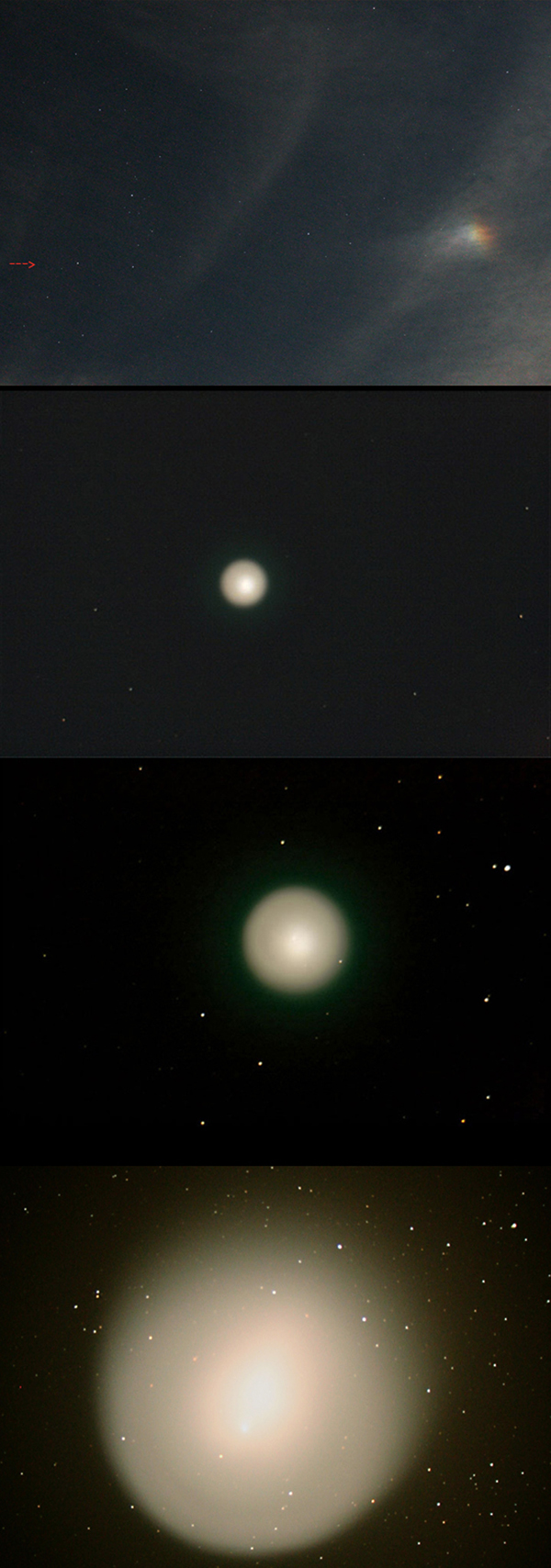| |
 |
The Adventures of Comet Holmes
On October 24, 2007, Comet Holmes
burst onto the scene. Amateur comet
observers began to report that this normally very dim comet, beyond the orbit
of Mars, was brightening extremely rapidly. Within 24 hours, it had brightened by
about 400,000 times, and was visible to the naked eye, looking like a new star
in the constellation Perseus. No other comet has ever been seen
brightening at such speed.
I went out to look on the evening
of October 25, but I was not expecting much because there were a bright Moon
and high thin clouds in the sky. As
the clouds drifted by, I was amazed to see the new “star” in Perseus (seen to the right of the red arrow in the top
picture). Also seen in this picture
is a “moon dog”—the rainbow colored patch in the clouds,
which is caused by ice crystals in the atmosphere bending the Moon’s
light like miniature prisms.
I rushed to set up my 12-inch
Meade, and snapped a series of short exposures (second image from the
top). When I looked through the
telescope, I observed the most bizarre comet I had ever seen. It was very bright, almost perfectly
round, with a sharp edge and a small brighter nucleus. The bright circle was surrounded by a
much dimmer halo, which is blue-green in the photograph.
Over the next several days, the comet’s
brightness did not change much, and people throughout the northern hemisphere
could see it easily with the naked eye if they knew where to look. The comet’s size, however, was
rapidly increasing. The third image
from the top was taken just two nights later, and the comet’s diameter
had more than doubled.
As the days passed, the
comet’s appearance to the naked eye gradually changed. First, it started to look fuzzier than a
star, and it slowly grew larger, fuzzier, and more diffuse. The bottom image, taken about two weeks
later, shows that Comet Holmes had gotten much bigger, and the bright central
region had a teardrop shape. The
comet also had a short tail (the diffuse edge to the upper right). The tail never appeared very large from
our vantage point, because it was pointing almost directly away from Earth.
What caused all this to
happen? One theory is that warming
by the Sun caused a build-up of gases beneath the comet’s surface, and
this eventually led to an eruption in which the gases and debris were expelled
into space. Whatever the reason,
this was not the first time Comet Holmes had such event. In the years 1892-93, the comet had two
such outbursts, about two months apart, and it was then that the comet was
discovered by an English amateur astronomer, Edwin Holmes.
Image details: All images taken with a Canon 400D
camera, and processed with ImagesPlus and
Photoshop. From top to bottom:
(1) October 25, 2007. A 4-second exposure at ISO 1600, taken
with a zoom lens at 27 mm lens, then cropped.
(2) October 25, 2007. From four 2-second
exposures and four 4-second exposures at ISO 1600 through a Meade 12”
telescope at f/10.
(3) October 27, 2007. From several 10-second exposures and
several 30-second exposures at ISO 1600 taken through a Meade 12”
telescope at f/10.
(4) November 7, 2007. A 60-second exposure at ISO 800, taken
through a Meade 12” telescope at f/2.8, then cropped.
|

